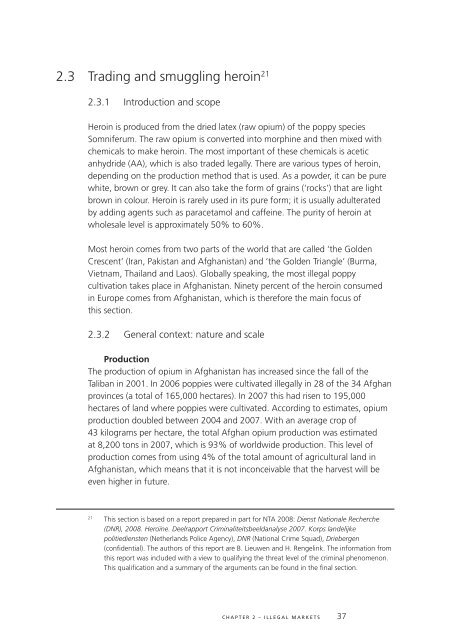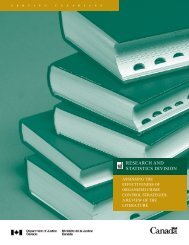National Threat Assessment 2008. Organised Crime - Politie
National Threat Assessment 2008. Organised Crime - Politie
National Threat Assessment 2008. Organised Crime - Politie
You also want an ePaper? Increase the reach of your titles
YUMPU automatically turns print PDFs into web optimized ePapers that Google loves.
2.3 Trading and smuggling heroin 21<br />
2.3.1 Introduction and scope<br />
Heroin is produced from the dried latex (raw opium) of the poppy species<br />
Somniferum. The raw opium is converted into morphine and then mixed with<br />
chemicals to make heroin. The most important of these chemicals is acetic<br />
anhydride (AA), which is also traded legally. There are various types of heroin,<br />
depending on the production method that is used. As a powder, it can be pure<br />
white, brown or grey. It can also take the form of grains (‘rocks’) that are light<br />
brown in colour. Heroin is rarely used in its pure form; it is usually adulterated<br />
by adding agents such as paracetamol and caffeine. The purity of heroin at<br />
wholesale level is approximately 50% to 60%.<br />
Most heroin comes from two parts of the world that are called ‘the Golden<br />
Crescent’ (Iran, Pakistan and Afghanistan) and ‘the Golden Triangle’ (Burma,<br />
Vietnam, Thailand and Laos). Globally speaking, the most illegal poppy<br />
cultivation takes place in Afghanistan. Ninety percent of the heroin consumed<br />
in Europe comes from Afghanistan, which is therefore the main focus of<br />
this section.<br />
2.3.2 General context: nature and scale<br />
Production<br />
The production of opium in Afghanistan has increased since the fall of the<br />
Taliban in 2001. In 2006 poppies were cultivated illegally in 28 of the 34 Afghan<br />
provinces (a total of 165,000 hectares). In 2007 this had risen to 195,000<br />
hectares of land where poppies were cultivated. According to estimates, opium<br />
production doubled between 2004 and 2007. With an average crop of<br />
43 kilograms per hectare, the total Afghan opium production was estimated<br />
at 8,200 tons in 2007, which is 93% of worldwide production. This level of<br />
production comes from using 4% of the total amount of agricultural land in<br />
Afghanistan, which means that it is not inconceivable that the harvest will be<br />
even higher in future.<br />
21<br />
This section is based on a report prepared in part for NTA 2008: Dienst <strong>National</strong>e Recherche<br />
(DNR), <strong>2008.</strong> Heroïne. Deelrapport Criminaliteitsbeeldanalyse 2007. Korps landelijke<br />
politiediensten (Netherlands Police Agency), DNR (<strong>National</strong> <strong>Crime</strong> Squad), Driebergen<br />
(confidential). The authors of this report are B. Lieuwen and H. Rengelink. The information from<br />
this report was included with a view to qualifying the threat level of the criminal phenomenon.<br />
This qualification and a summary of the arguments can be found in the final section.<br />
chapter 2 – Illegal markets<br />
37








